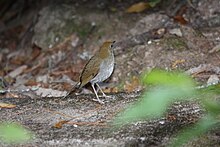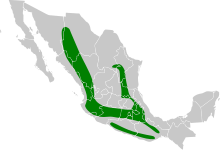The russet nightingale-thrush (Catharus occidentalis) is a species of bird in the family Turdidae. It is endemic to Mexico.
| Russet nightingale-thrush | |
|---|---|

| |
| Scientific classification | |
| Domain: | Eukaryota |
| Kingdom: | Animalia |
| Phylum: | Chordata |
| Class: | Aves |
| Order: | Passeriformes |
| Family: | Turdidae |
| Genus: | Catharus |
| Species: | C. occidentalis
|
| Binomial name | |
| Catharus occidentalis PL Sclater, 1859
| |

| |
Its natural habitat is subtropical or tropical moist montane forests.
Taxonomy
editIts closest relative is the hermit thrush (Catharus guttatus) of temperate North America.[2]
Description
editThe crown, back and wings of the russet nightingale-thrush are brown, and the face is pale gray. Its throat and belly are also pale gray, with a slightly washed dusky shade. The breast is similarly pale gray and mottled dusky. Juveniles are more strongly mottled on breast and sides than adults.[3]
This species is very similar to the related ruddy-capped nightingale-thrush (Catharus frantzii). They can be differentiated by song or in flight, by the presence of a yellow bar on the secondary feathers below the wing in the russet nightingale-thrush.
References
edit- ^ BirdLife International (2018). "Catharus occidentalis". IUCN Red List of Threatened Species. 2018: e.T22708639A131949048. doi:10.2305/IUCN.UK.2018-2.RLTS.T22708639A131949048.en. Retrieved 12 November 2021.
- ^ Winker, Kevin; Pruett, Christin L. (2006). "Seasonal Migration, Speciation, and Morphological Convergence in the Genus Catharus (Turdidae)". The Auk. 123 (4): 1052. doi:10.1642/0004-8038(2006)123[1052:SMSAMC]2.0.CO;2. ISSN 0004-8038.
- ^ Amadon, Dean (June 1961). "Life Histories of Central American Birds. II. Families Vireonidae, Sylviidae, Turdidae, Troglodytidae, Paridae, Corvidae, Hirundinidae and Tyrannidae. Pacific Coast Avifauna, No. 34.Alexander F. Skutch". The Quarterly Review of Biology. 36 (2): 128–129. doi:10.1086/403342. ISSN 0033-5770.
Further reading
edit- Skutch, Alexander F. (1960). "Russet nightingale-thrush" (PDF). Life Histories of Central American Birds II. Pacific Coast Avifauna, Number 34. Berkeley, California: Cooper Ornithological Society. pp. 101–110.
